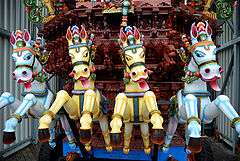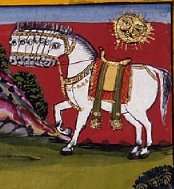Ashva
Ashva (aśva, अश्व) is the Sanskrit word for a horse, one of the significant animals finding references in the Vedas as well as later Hindu scriptures. The word is cognate to Avestan aspa, Latin equus, Greek ἵππος (hippos), Germanic *ehwaz and Baltic *ašvā all from Proto-Indo-European *h₁éḱwos.

Vedic period
There are repeated references to the horse the Vedas (c. 1500 - 500 BC). In particular the Rigveda has many equestrian scenes, often associated with chariots. The Ashvins are divine twins named for their horsemanship. The earliest undisputed finds of horse remains in South Asia are from the Swat culture (c. 1500 - 500 BC).
Puranic legend

The legend states that the first horse emerged from the depth of the ocean during the churning of the oceans. It was a horse with white color and had two wings. It was known by the name of Uchchaihshravas. The legend continues that Indra, king of the devas, took away the mythical horse to his celestial abode, the svarga (heaven). Subsequently, Indra severed the wings of the horse and presented the same to the mankind. The wings were severed to ensure that the horse would remain on the earth (prithvi) and not fly back to Indra's svarga.
Archaeology
Paleolithic
Remains of the Equus namadicus have been found from Pleistocene levels in India.[1] The Equus namadicus is closely related to the Equus sivalensis.[2] The Equus sivalensis lived in the Himalayan foothills in prehistoric times and it is assumed it was extinct during the last Ice Age.
Bronze Age
Remains of horses have been claimed to have been found in deposits at Mahagara near Allahabad (dated to around 2265 BC to 1480 BC, described as Equus ferus caballus Linn), Hallur in Karnataka (c.1500 - 1300 BC, described as Equus ferus caballus), Mohenjo-Daro, Harappa ("small horse"), Lothal[3] (e.g., a terracotta figurine and a molar horse tooth, dated to 2200 BC), Kalibangan, and Kuntasi (dated to 2300–1900 BC). Horse remains from the Harappan site Surkotada (dated to 2400-1700 BC) have been identified by A.K. Sharma as Equus ferus caballus. The horse specialist Sandor Bökönyi (1997) later confirmed these conclusions and stated the excavated tooth specimens could "in all probability be considered remnants of true horses [i.e. Equus ferus caballus]". Bökönyi stated that "The occurrence of true horse (Equus caballus L.) was evidenced by the enamel pattern of the upper and lower cheek and teeth and by the size and form of incisors and phalanges (toe bones).".[4] However, archaeologists like Meadow (1997) disagree, on the grounds that the remains of the Equus ferus caballus horse are difficult to distinguish from other equid species such as Equus asinus (donkeys) or Equus hemionus (onagers).[5] An alleged clay model of a horse has been found in Mohenjo-Daro and an alleged horse figurine in Periano Ghundai in the Indus Valley.[6]
Trautmann (1982) thus remarked the supply and import of horses has "always" been a preoccupation of the Indians and "it is a structure of its history, then, that India has always been dependent upon western and central Asia for horses."[7] The paucity of horse remains could also be explained by India's climatic factors which lead to decay of horse bones. Horse bones may also be rare because horses were probably not eaten or used in burials by the Harappans.[8]
Other sites, such as the BMAC complex (which some consider as Indo-Iranian), are at least as poor in horse remains as the Harappan sites.[9][10] The horse only appears in Mesopotamia from around 1800 BC as a ridden animal and acquires military significance with the invention of the chariot. Domestication of the horse before the second millennium appears to be confined to its native habitat (the Great Steppe).
Colin Renfrew (1999) also remarked, "the significance of the horse ... has been much exaggerated",[11] and Bryant holds, "using such negative evidence, by the same logic used to eliminate India as a candidate, ultimately any potential homeland can be disqualified due to lacking some fundamental Proto-Indo-European item or another".[12] Renfrew's statement refers to his own Anatolian hypothesis, which is criticized by mainstream scholarship on similar grounds.
In RV 1.162.18, the sacrificial horse is described as having 34 (2x17) ribs:
- The four-and-thirty ribs of the Swift Charger, kin to the Gods, the slayer's hatchet pierces.
- Cut ye with skill, so that the parts be flawless, and piece by piece declaring them dissect them. (trans. Griffith)
Frawley (2005) speculates[13] that the Rigvedic horse could therefore be the Indian Equus sivalensis (which may or may not have had 34 ribs; modern horses usually have 36, with occasional specimens of 34 or 38).
In Baltic languages
The word Ašva is recorded as a noun meaning female horse in Prussian Lithuanians language. References however are few, as the word had almost fallen out of use at the time, and include: Lexicon Germano-Lithvanicvm et Litvanico-Germanicvm, darinnen... von Iacobo Brodowskij, Praecentore Trempensi (written somewhere between 1713 and 1744); Littauisch-Deutsches und Deutsch-Littauisches Lexicon. Königsberg. 1744; Littauisch-deutsches und Deutsch-littauisches Wörter-Buch. Königsberg. 1800; Littauisch-deutsches Wörterbuch von Friedrich Kurschat. Halle a. S.1883.; Wörterbuch der Littauischen Sprache von G. H. F. Nesselmann. Königsberg 1851.;
See also
- Ashvamedha
- Ashvins
- Ratha
References
- Kennedy 2000
- Arun Sonakia and S. Biswas, Antiquity of the Narmada Homo erectus, the early man of India, 1998, Palaeontology Division, Geological Survey of India ; Biswas, S., Rec. GSI, 1988, 118, 53–62.
- Bryant 2001; S.R. Rao (1985) Lothal - A Harappan Port Town
- (quoted by Prof. B.B. Lal from Bökönyi's letter to the Director of the Archaeological Survey of India, 13-12-1993, in New Light on the Indus Civilization, Aryan Books, Delhi 1998, p.111)
- (see Edwin Bryant. 2001:169-175)
- Bryant 2001:171, with reference to Mackay 1938 and Piggott 1952
- (Bryant 2001)
- Bryant 2001:194; S.P. Gupta. The dawn of civilization, in G.C. Pande (ed.)(History of Science, Philosophy and Culture in Indian Civilization, ed., D.P. Chattophadhyaya, vol I Part 1) (New Delhi:Centre for Studies in Civilizations, 1999)
- Bryant 2001
- Hastinapura (8th century BCE) is likewise poor in horse remains, even though it is considered as Indo-Aryan. Thapar 1996:21. The theory of Aryan race and India. Social Scientist, Delhi.
- Bryant 2001:120
- (Bryant 2001: 120)
- Frawley: Myth of Aryan Invasion, 2005
| Wikimedia Commons has media related to Tempelwagen Hamm. |
- Dictionary of Hindu Lore and Legend (ISBN 0-500-51088-1) by Anna Dallapiccola
- Lietuvių kalbos žodynas
Further reading
- Kak, Subhash (2004). The Aśvamedha: The rite and its logic. Motilal Banarsidass.
- Kazanas, N. Anatolian bull and Vedic horse in the Indo-European diffusion. 2005. Adyar Library Bulletin (2003)